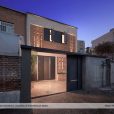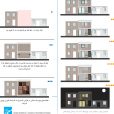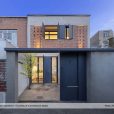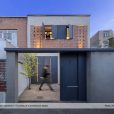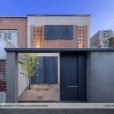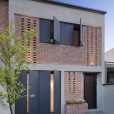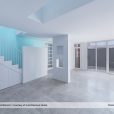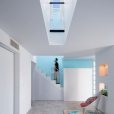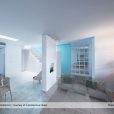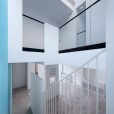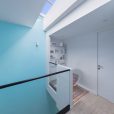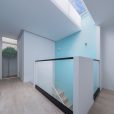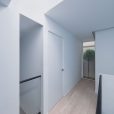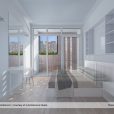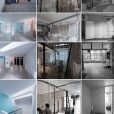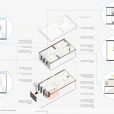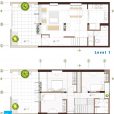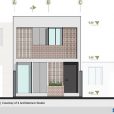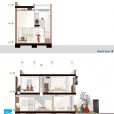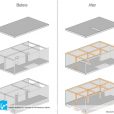خانه حیاتدار
استودیو معماری چهار (محمدیوسف صالحی، محمدصادق افشارطاهری، کسری شفیعیزاده، محمدرضا پیری)
موقعیت: تهران، ایران
تاریخ: ۱۳۹۸
مساحت: ۱۲۰ مترمربع
وضعیت: ساختهشده
کارفرما: سعید شعبانی
تیم طراحی: آذین ساوهدورودی، ایمان اسلامی
طراح سهبعدی: هلیا مرادزاده، شیوا غفاری
سازه: فرزاد برازنده
اجرا: محمدرضا پیری، استودیو معماری چهار
گرافیک: فرشید نصر آزادانی
عکس: پیمان امیرغیاثوند
تجربه «خانه حیاتدار» برای ما، تجربه بازتعریف روح معماری ایرانی با ظاهری امروزی بود. ارزشنهادن به روح میتواند هر قالبی بپذیرد، یا به عبارتی، فارغ از قالب است، کشف چیزی است که وجود دارد، نه خلق چیزی که نیست؛ سفری است از خود به خود، بدون نیاز به یک قدم حرکت در هیچ جهتی؛ فقط بودن، کشفکردن، و لذتبردن در اینجا و اکنون. اما در تفکر بسیاری از مردم ایران، توسعه و ارزش به مثابه دوری هر چه بیشتر از سنتها و اصول تلقی میشود و خانههایی با کاراکتر جدید و ناآشنا بیشتر مورد پسند بازار مسکن قرار میگیرد، بازاری که زاده تفکرات سرمایهداری، مصرفگرایی و سوداگران ساختمانی است. هر روز شاهد «کوبیدن» ارزشها و «ساختن» بیهویتی هستیم، در حالی که دورشدن از اصل، همواره باعث دردی میشود که روان آدمی را به بازگشت دعوت میکند؛ به قول مولانا؛ «هر کسی کو دور ماند از اصل خویش / باز جوید روزگار وصل خویش»
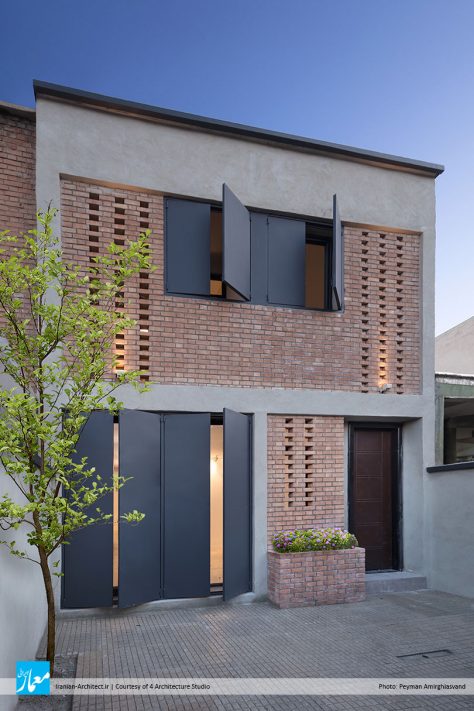
این پروژه در حالی به ما ارجاع داده شد که یک ساختمان دوطبقه متروک با مشکلات تاسیساتی و سازهای جدی بود. اما نیت کارفرما دوستداشتنی بود؛ او با سرمایه محدودی که داشت، ترجیح داده بود خانهای با حالوهوای خانه پدری خودش پیدا کند تا فرزندانش در آپارتمانهای بیروح بزرگ نشوند، بلکه کودکیکردن را بیاموزند و بودن را حس کنند. از بدو ورود به سایت پروژه، میتوانستیم حس خانه را درک کنیم، و لذا طراحی چنین فضایی کار سختی نبود؛ همه چیز آنجا بود، ما فقط باید کمی صیقلش میدادیم تا روحش نمایان شود.
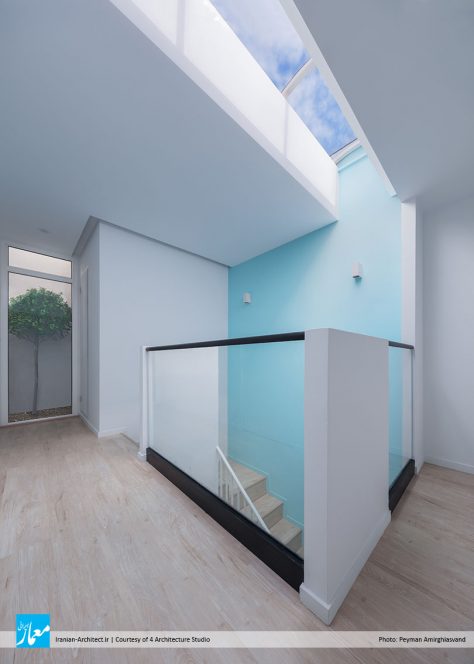
از همان ابتدای طراحی، برای خودمان قرارهایی گذاشتیم. قرار اول طراحی ما این بود که «چیزی به آنجا اضافه و یا از آنجا کم نمیشود.» بر همین اساس، برای طراحی نما، از طرح آجرها با چینش موجود در خانه استفاده شد، طاقچهها برای کاربردهای جدید بازتعریف شدند، و آهنهای خام، سیمان، چوب، کاشی و گچ، ابزارهای ما برای طراحی بودند که جایی برای سلیقه شخصی طراح باقی نمیگذاشتند. حفظ سادگی این خانه، قرار دیگرمان بود؛ هیچ چیز برای زیبایی، بیدلیل اضافه نمیشد، چرا که عریانی باعث ظهور فضا از پس مادهها میشد. قرار آخرمان این بود که اگرچه این خانه حیاط کوچکی برای بازی کودکان دارد، ولی خانهای حیاتدار طراحی کنیم، یعنی فضاهای غیرمکلف را افزایش دهیم تا کاربر خودش طرح را کامل کند و خلاقیت و انعطاف بر آن حاکم باشد. از اینرو، حس کشف و بازیگوشی را در طراحی مقاطع اضافه کردیم، به گونهای که وویدها در عین ایجاد سیالیت بیشتر در فضا و تامین ارتباط بهتر دو طبقه، اطلاعات کاملی از اتفاقات جاری در طبقات نمیدهند، و آینهها نیز به دیدهای مبهم در پروژه میافزایند.
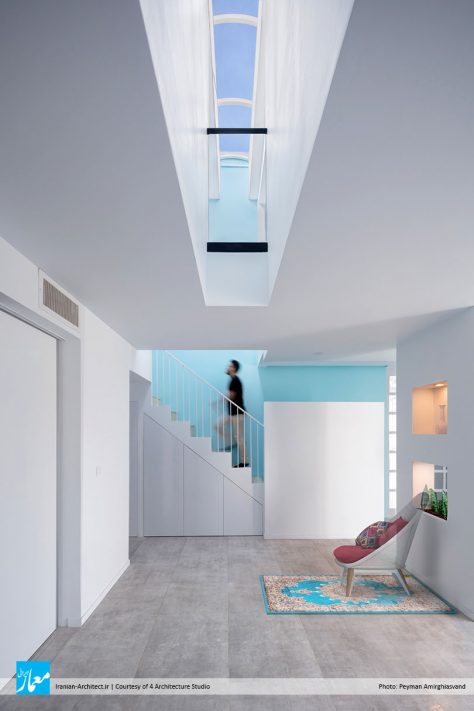
کارفرما نگران نزدیکی بیش از حد خانههای مجاور و حریم خصوصی خود بود. همچنین به دلیل ناامنی منطقه، نیاز به حفاظهایی داشت که امنیت خانه و خانواده حفظ شود. از پس نگرانی کارفرما، مشخص بود که فضایی امن و به دور از همهمههای شهر میخواهد. در نتیجه، جداره پروژه ما برگرفته از این ذهنیت کارفرما، به یک فیلتر تبدیل شد که ارتباط با ناموزونیهای بیرون خانه را به حداقل میرساند، و در صورت تمایل، بخشی از این فیلتر باز یا بسته میشود. از چیدمان آجر موجود در خانه نیز به عنوان راهکاری برای ورود نور، بدون نگرانی از اشرافیت خانههای مجاور استفاده شد. همچنین حفاظهای پنجرهها به المانی در طراحی نما تبدیل شدند که باعث تغییر و پویایی نما میشود. در نهایت، بام پروژه تنها جدارهای بود که بدون نگرانی میتوانست نور را به قلب پروژه بپاشد و همچنین آسمان را بخشی از سقف خانهمان کند.
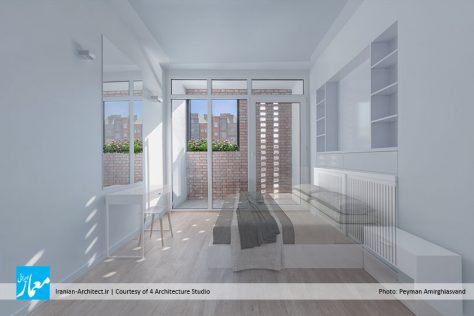
خانه حیاتدار تنها خانه بازسازیشده در کوچه خودش است. از اینرو، نمای آن بسیار با احتیاط و حساسیت طراحی شد، و رنگ مصالح و خطوط نما تا حد امکان برگرفته از خانههای مجاور است تا متواضع و همگون، در کنار همنشینانش بنشیند. در نورپردازی پروژه نیز تا حد امکان از نورهای مخفی و سایهروشنها استفاده شد تا حسوحال روز با شب تناسب داشته باشد، ضمن اینکه روشن و خاموششدن چراغ اتاقها و تغییر زاویه تابش خورشید باعث پویایی نما و پروژه میشود. همچنین سازه این پروژه به شدت نگرانکننده بود و بیشترین هزینه و نیروی انسانی را برای تبدیلشدن از یک سازه سنتی و نشستکرده به ترکیب سازه فلزی با فونداسیون منفرد و دیوارهای باربر تقویتشده، به خود اختصاص داد.
Khaneye Hayatdar
4 Architecture Studio (Mohammad Yousef Salehi, Mohammad Sadegh Afshar Taheri, Kasra Shafieezadeh, Mohammadreza Piri)
Location: Tehran, Iran
Date: 2020
Area: 120 sqm
Status: Completed
Client: Saeed Shabani
Design Team: Azin Savehdoroudi, Iman Eslami
3D Modeling: Shiva Ghaffari, Helia Moradzadeh
Structure Consultant: Farzad Barazandeh
Construction: Mohammadreza Piri, 4 Architecture Studio
Graphic: Farshid Nasr Azadani
Photo: Peyman Amirghiasvand
The experience of “Khaneye Hayatdar” for us, was an experience of redefining the soul of Iranian architecture with an avant-garde appearance. Appreciating the soul can take any form, or in other words, it is independent of forms. It is the discovery of what exists, not the creation of something nonexistence. It is a journey from a self to its own, without the need for a single step in any direction; Just being, discovering, and enjoying, here and now.
In the minds of the Iranian majority, development and value are considered to get as far away from traditions and principles as possible. Houses with new and unfamiliar characters are more popular in the housing market, a market born of capitalist thinking, consumerism, and building traders thinking. Every day, we see “hitting” values and “building” anonymity, while deviating from the principle always causes pain that invites the human soul to return to its source; In the words of Rumi: “Anyone who stays away from his origin / will always search for it.”
The project was referred to us while it was a desolate abandoned building with serious installation and structural problems. The intention of the client was lovely; With a low and limited budget he had, he preferred to find a home with the atmosphere of his childhood house, so that his children would not grow up in lifeless apartments, let them be a child, feel the being, and just be. From the moment we entered the project site, we could understand the feeling of home. Designing such a space was not difficult; Everything was there, we just had to polish it a little, to make its spirit shine from the background.
We made rules for our design process. Our first design rule was “Nothing will be added or subtracted.” The old brick pattern was used to design the facade with the layout of the house, and the old shelves were redefined for new functions. Also, raw steel, cement, woods, tiles, and plasters were our tools for the design that left no room for the designer’s personal taste. Preserving the simplicity of this house was our other rule; Nothing was added for just beauty aspects, because nudity would reveal the spirit of the space from the background of mind and matter.
Our final decision was that although this house has a small yard for children to play, we would design a house with spirit. ”House with spirit” is the English definition of “Khaneye Hayatdar”. We would increase nonessential functions for some spaces, so that the user can complete the design himself, and creativity and flexibility prevail. We’ve added a sense of discovery and playfulness to the design of the sections, and in addition to creating more fluidity in the space and better connection between the two floors, also do not provide complete information about events going on the floors, to make the house more interesting and mysterious. Mirrors also add ambiguity to the project.
The wall, based on the mentality of the client, has become a filter that minimizes the connection with out-of-home unbalances, and if desired, part of this filter would be opened or closed. The pattern of the bricks was used as a way to enter the light without worrying about the privacy of the neighboring houses. Also, the window protectors became an element for facade design, which made the facade more dynamic and created a nice play and variation for the facade. The roof of the project was the only surface that could shed light on the heart of the project without worry, and the sky could be part of the roof of our project.
“Khaneye Hayatdar” was the only house renovated on the alley. Its facade was designed with great care and sensitivity. The materials and the design grids were taken from the neighboring houses as much as possible, so that he could sit modestly and harmoniously with his companions.


